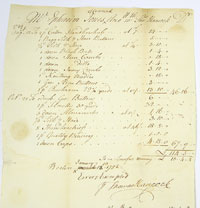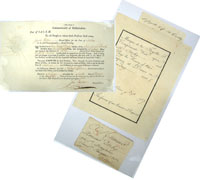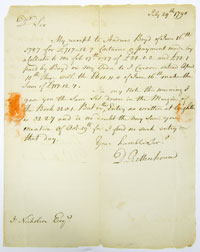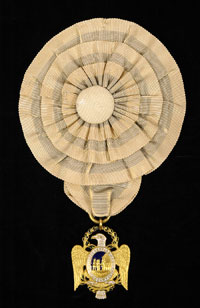
|
Sale 58
Manuscript, Collectibles and Aerospace Auction
| Lot |
Photo |
Description |
Realized |
Lot 53 |
 |
Hancock, Thomas (1703-1764) Wealthy Boston merchant; uncle and guardian of John Hancock, to whom he left his fortune. Manuscript Document Signed "Thomas Hancock," one page, 11¾ x 7½ in., Boston, Jan. 12, 1752. Being a detailed merchant account of transactions between Mr. Epharim Jones of Concord and Hancock from August 12, 1949 through October 12, 1749. The account consisted of items such as handkerchiefs, buttons, ivory combs, and fabric. Fold toning, a couple of faint stains, lower edge chips. Boldly penned and signed.
Estimated Value $200 - 300.
View details and enlarged photo
| Unsold |
Lot 54 |
 |
Lafayette, Marquis de. Partly Printed Document completed in manuscript, one page, 8¼ x 6½ in., Paris, February 3, 1787. In English. In full, "Marquis de la Fayette�s Compliments Wait upon Mr Derby and Begs the Honour of His Company, at Dinner on Monday next. Paris Feb. 3rd 1787. The favour of an Answer is Requested." The text is enclosed in a 6¼ x 4 in. double-bordered rectangle. Accompanied by the front panel of the original 2¾ x 4 in. envelope, addressed in an unknown hand to "Monsieur Derby" in Paris. Fine condition.
Also, Partly Printed Document Signed "Jos. Hiller" as Naval-Officer, one page, 7½ x 12½ in., Salem, December 6, 1787. "Bill of Health" for Elias Hasket Derby�s ship "Grand Turk" bound for the Isle of France (today, Mauritius). This document certifies that "there is not in the said Port of Salem any Pestilence or contagious Distemper whatever." Fine embossed Naval Office seal at left. Fine condition with professional repair to top right corner. Joseph Hiller (1748-1814) was a silversmith when he enlisted to fight in the Revolutionary War, rising to Major. In 1789, President George Washington appointed Hiller the first Collector of the Port of Salem; he served until 1803.
American merchant and shipowner Elias Hasket Derby (1739-1799) of Salem, Massachusetts, often referred to as America�s first millionaire, opened American trade to the Indian Ocean and China in the 1780s. At the outbreak of the Revolutionary War, Derby owned a fleet of seven ships, but four were captured by the British. A staunch patriot, Derby gave money and supplies to the Continental army and converted his remaining three vessels to privateers, which permitted him to arm his ships and attack enemy vessels, being awarded a share of the cargo (the government claimed the rest). As the owner of privateers, Derby increased his fleet to 85 vessels and captured 144 enemy ships. His business continued to prosper after the war. His ship, "Grand Turk," returned to Salem in May 1787 from a voyage to the Cape of Good Hope, Île de France, and Canton, China, with a cargo of tea, cassia spice, hides, silk, and porcelain. This Bill of Health was for the next voyage of "Grand Turk.".
Estimated Value $1,800 - 2,200.
View details and enlarged photo
| Unsold |
Lot 55 |
 |
Rittenhouse, David (1732-1796) American astronomer, scientist, and inventor; first director of the U.S. Mint (1792-95). He built what is believed to be the first telescope in the U.S., as well as two orreries (mechanical models of the solar system). During the American Revolution, he was a member of the Committee of Safety and the Pennsylvania War Board. From 1777-89 he served as treasurer of Pennsylvania. He used his surveying expertise and advanced instruments to establish the Mason Dixon line (1784) and other state boundaries, and in 1791 he succeeded Benjamin Franklin as president of the American Philosophical Society.
Rare Autograph Letter Signed "D. Rittenhouse" one page, 8¼ x 6½ in. (Philadelphia), July 29, 1790. To U.S. Comptroller General John Nicholson with regard to Rittenhouse's ledger notations in his capacity as treasurer of Pennsylvania in 1787, most probably referencing his accounting for Revolutionary War claims: "My receipt to Andrew Boyd of June 16th 1787 for £717.12.7 Contains a payment made by a Collector to me feb. 27th 1787 of £34.0.3 and £73.1 paid by Boyd on my Order to J. Carson entered April 10th these with the £610.11.4 of June 16th make the Sum of £717.12.7. In my note this morning I gave you the Sum Set down in the Margin of the Book 32.0.1. But in the Entry as written at lenghth [sic] is 32.2.7 and is no doubt the very sum you mention of Oct. 19th for I find no such entry on that day…." With holograph address panel on integral leaf. Very good; edge chips and small tear at right center margin; seal remnants do not affect legibilty; fold repairs on verso. Darkly penned and signed. Thomas Jefferson once wrote to Rittenhouse, "There is an order of geniusses above [the] obligation…of government…the world has but one Ryttenhouse &…it never had one before…."
John Nicholson was Comptroller General of Pennsyvania from 1782 until 1794. Having been under suspicion for shady dealings for some time, he was impeached but acquitted. He became involved in various land speculation schemes with Robert Morris, which eventually bankrupted both men and landed them in debtor's prison. Nicholson died there in 1800.
Estimated Value $4,000 - 6,000.
View details and enlarged photo
| Unsold |
Lot 56 |
 |
Society of the Cincinnati Eagle Insignia For New York. Gold with colored enamels, 38mm x 29mm. One of ten eagles produced for New York in 1896 by jeweler John R. Gleason, only two of which are known to exist. The eagle is suspended from a cockade ribbon in excellent condition. The presence of the cockade suggests that this eagle once belonged to an officer of the Society, or the General Society.
Obverse: Head left. Medallion with three senators presenting sword to Cinvinnatus, with wife and two children. Motto: OMNIA RELIQUIT SERVARE REMPUBLICAM*. As with other New York badges of the period, eye of eagle has pupil within an outline. Characteristic of this design is the smooth curve which runs from one talon through the bow and through the other. The beak is another smooth curve. Reverse: Cincinnatus in field, with Fame above, sunset, ships, and city behind. Motto: SOCIETAS CINCINNATORUM INSTITUTIA AD 1783*. Myers #46.
The General Society of the Cincinnati was founded in New York in 1783 by Continental Army officers who fought in the American Revolution.Within a year, affiliated Societies were founded in all 13 of the original states and France. George Washington was elected the first President in December 1783 and served until his death in 1799, when he was succeeded by Alexander Hamilton.
The Society was named for Lucius Quintus Cincinnatus, a 5th century B.C. Roman farmer who, like Washington, triumphantly lead his country's troops in battle, then returned home to plow his fields, refusing any honors. The Society's motto is: "He gave up everything to serve the republic." The Society of the Cincinnati is the oldest military hereditary society in the United States. Membership passes through the eldest son of the eldest surviving son successively of an original member. The Society was also the first military beneficial society. At a time when there were no military pensions, officers who were original members of the Society were required to give one month's pay, the interest of which was used for needy officers and their families.
Original Members of the Society of the Cincinnati included General Henry Knox, considered the Society's originator; General Friedrich William von Steuben, the Society's first presiding officer; Alexander Hamilton; General Nathanael Greene; Commodore John Barry; and Captain John Paul Jones. Foreign officers who fought in the American Revolution also became members. They included Generals Lafayette and Rochambeau and Admiral de Grasse from France, and Colonel Thaddeus Kosciuszko from Poland.
Estimated Value $25,000 - 35,000.
View details and enlarged photo
| Realized
$32,900 |
Lot 57 |
 |
St. Clair, Arthur (1734-1818) As a Revolutionary War general, St. Clair surrendered Ticonderoga to the British, for which he was court martialed and acquitted. He served as president of the Continental Congress (Feb. 2-Nov. 4, 1787) and as governor of the Northwest Territory (1789-1802) and was largely responsible for the expansion to the Northwest Territory.
Autograph Letter Signed "A St. Clair," 2pp, 10½ x 8 in., recto/verso, Chestnut Ridge, Westmoreland County, Pennsylvania, March 4, 1813. To three New York ladies, including Miss Wooster Jr. and Mrs. Riker. Begins, In part, "About a fortnight ago I received through Mr. Mountain of Pittsburgh, the Letter you did me the honor to write to me on the 2d of February, together with its enclosures, to wit, a Check on the Bank of Philadelphia for five hundred Dollars � Had I not been ill since, the receipt of that Letter would have been sooner acknowledged for it was of nature that demanded a prompt acknowledgment. It is not easy, Ladies to imagine the astonishment with which that, I believe unparalleled instance of the generous disinterested Bounty of the Ladies of New York struck me, so very few of whom I have the honor to be personally known…tho� the frost of many Winters are upon my Head � My Heart is not yet so cold as to be insensible to female Praise � it conveyed a Balm to my wounded Spirit. Wounded not by the loss of fortune and the need of pecuniary aid, but by Confine obloquy and contumely whom I thought (and now since I have their approbation I say it boldly), I thought I had least merited thanks, for, to say nothing of my military services which they have so kindly eulogized. I had, in a great measure at my own expense, raised up for the United States in fifteen years a Colony from thirty Men to upwards of sixty thousand � amalgamated the most heterogeneous Mass of population � carried Laws, Religion, Morals and Manners to the extremest limit of New territory � made the people happy and laid a foundation for the continuance of that happiness to Millions yet unborn and in which every faculty of mind and Body has been unremittingly employed.…" Thin mounting strip at left edge of first page. Tear in lower portion and slight separations have been expertly repaired by silking. Fine condition.
In his late seventies, St. Clair was living in a log-house on the summit of Chestnut Ridge in the Allegheny Mountains. He lived in poverty and existed on generous gifts, unpaid loans, and claims against the government for money advanced to help recruit soldiers during the Revolutionary War. When he petitioned the Congress and the State of Pennsylvania for relief, word of his dire circumstances became public knowledge, and three ladies from New York sent him $500. Later in 1813, Pennsylvania granted him an annuity. On March 9, 1818, President James Monroe signed "An act for the relief of Major General Arthur St. Clair." Five months later, on August 31, 1818, Revolutionary War Major General and former President of the United States in Congress Assembled Arthur St. Clair died at the age of 82.
Estimated Value $3,000 - 4,000.
View details and enlarged photo
| Unsold |
|
|